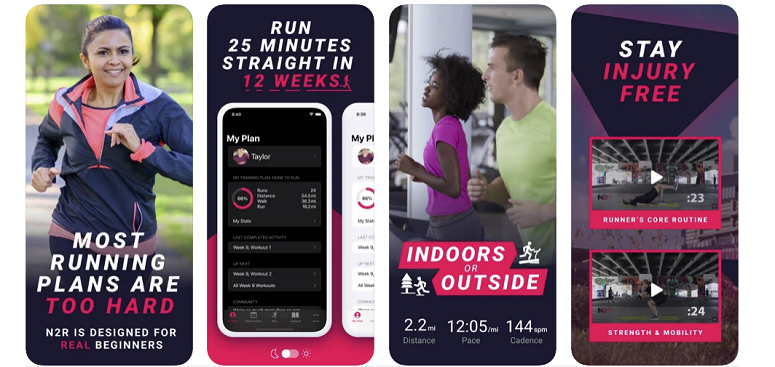None to Run App Review

Get the Running Habit with None to Run on Apple Devices
The None to Run app is one designed for people that are intent on taking up running for the first time. Within the app is a 12-week program that takes you from no running at all, to a fitness level where you’ll be able to run for 25 minutes straight.
Aside from the main plan to get you running there are two other components worth noting.
- Training for 5k and 10k races
- Strength training
- The None to Run Community, which includes podcasts
On this page you get to find out all about the None to Run app. How it works, the user friendliness of the app, the running plans and how the app can interact with your other fitness apps. None to Run have a bone to pick with ‘Couch to 5k’, read on to find out more!

Setting Up the None to Run App
The first thing you need to do is head to the App store and search for None to Run. Installing is a quick process that should take less than a minute. There are versions for iPhones and for Apple Watches. It is not available for Android users. If you do use Android, then Couch to 5k makes a great alternative.
When you launch the app, the first step is to set up your profile. This can be done manually by entering your details or you can immediately link it to your health app. If using the app manually, you will be asked to enter your weight in pounds. At this point you are ready to go.
How the None to Run App Works and User Friendliness
There are five menu options at the bottom of the app:
My Plan:
This section gives you an overview of your own personal plan. It tells you your next run and offers further advice by signing up to the larger program that will have even have you race ready. Access to the Facebook community (a great support option) is also found here. Any FAQs you might have can also be searched here. You can also apply for a free email course that is designed for beginner runners.
None to Run:
This is the main section of the app that tells you all about the running plans, telling you exactly what you will be doing in terms of running from week to week (further details below).
Run:
When you are ready to start your first run (and all subsequent ones) you’ll head to this section. The app will ask you if you want to turn on GPS to fully tack your run and whether you want the run to be reported to your health app.

Logbook:
This is the section where you can store any runs and look back at your progress. This is the section that you will look back on with pride having completed the entire course.
More:
In this section you can find out more about the app, contact help and support, look at the settings and change permissions (for example, you might have opted not to interact with the health app, but have now changed your mind).
None to Run has Easy Navigation
Overall, the app is user friendly and easy to navigate. The interactivity with the Apple health app is a useful addition that means all of you fitness activity can be kept in one place. The app isn’t huge on visuals, simply concentrating on giving you the information you need concisely.
The None to Run Fitness Plan
The fitness plan itself takes place over 12 weeks and requires you to complete four workouts every week.
Here is a look at what is required of you in week 1:
For each of the three running workouts, you will be asked to start by briskly walking for 5 minutes. You will then be asked to alternate between 30 seconds of slow running and 2 minutes of walking for a further twenty minutes. At the end of this your first workout is done.
You will repeat this three times in the first week (it is recommended that you leave a day between each workout). Each week you will also be asked to do a strength workout. In the first week this will be 30 seconds of body weight squats, a glute bridge with march for 45 seconds and a side leg raise for 30 seconds. If you are unsure about what any of these are, head to YouTube where you will find an instructional video.
As you move from week to week, the runs grow in their intensity. For example, by week 6 you will be running for 90 seconds at a time and only walking for 1 minute in between, with an extra 5 minutes of overall time.
By the time you reach week twelve, there will be no walking at all. By the end of that week, you will be able to complete a 25-minute run straight through, and you will have done that 3 times. When you have done the 7-minute strength workout at the end, you will have graduated, and you can now officially call yourself a runner.

None to Run vs Couch to 5k App
None to Run make a light-hearted dig at Couch to 5k on their website. They point out that Couch to 5k misses something vital to overall health and fitness – strength training. Even if you are a fan of running and have no desire to bulk up, some strength training is vital to overall fitness.
You also get podcasts at None to Run. These take you through success stories, running techniques and are a great accompaniment to your run (I also enjoy podcasts while working!).
On the plus side for Couch to 5k – this is available for both Android and Apple devices. It is free, and created by the NHS.
Paid 5k and 10k Training Plans
Once you have developed a running habit, it is time to take things to the next level. 100’s of 5k and 10k races take place in the warmer months. These are social and entertaining – and are also a wonderful way to keep you motivated to run.
None to Run plans cost £25 at the time of writing. They will take you through the steps needed to finish those races. After you tick 10k off your list, I’m sure your mind will be focused on a half-marathon.
The winter months are not ideal for getting into the running habit. I recommend investing in a home treadmill. If you get one that works with fitness apps, scenic maps and has incline / decline features, it will feel very much like an outdoor run.
More Popular Pages this Month:
- FITT Cube (all in one mini gym in a box)
- The amazing TT8 Treadmill from Sole
- How Your Microbiomes Affect Fitness Goals
- Best Toning Belts for Women
- Cognitive Behavioural Therapy for Insomnia and Fitness

